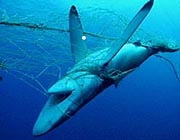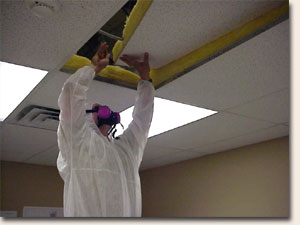Water Pollution (6/7)
Plastics

Plastics are so durable that they will not rot or decay as do natural products such as those made of wood. As a result, great amounts of discarded plastic products accumulate in the environment as waste. Plastics are harmful to marine life when ingested, as when a sea turtle mistakes a drifting sandwich bag for a jellyfish and subsequently chokes on it. They are also entanglement hazards, from plastic six-pack bands that can kill birds and other small creatures to drifting ropes and nets which can strangle whales. It has been suggested that plastics could be made to decompose slowly when exposed to sunlight by adding certain chemicals to them.
Asbestos


Asbestos is the common name for any of a variety of silicate minerals within the amphibole and serpentine groups that are fibrous in structure and more or less resistant to acid and fire. It is a naturally occurring mineral that is still mined in Australia, Canada, South Africa, and the former Soviet Union. Asbestos-bearing minerals are categorized into two groups. The first is called "serpentines" and has a layered sheet-like structure. The second is called "amphilboles" and is chain-like.
Because asbestos fibers are resistant to heat and most chemicals, they have been mined for use in a variety of products ( over 3,000 different products in the United States. ) In 1988, asbestos was consumed in roofing products, 28%; friction products, 26%; asbestos cement pipe, 14%; packing and gaskets, 13%; paper, 6%; and other 13%. Pipe products find use in water supply, sewage disposal, & irrigation systems. Asbestos cement sheets are used in a wide variety of construction applications. Other uses of asbestos include fire-resistant textiles, friction materials ( ie, brake linings ), underlayment & roofing papers, & floor tiles. Crocidolite can be spun & woven using modified cotton industry machinery; the asbestos cloth is used for fireproof clothing & curtains.

Since the 1960s, asbestos has been recognized as a potent carcinogen and serious health hazard. This mineral is unhealthy when the microscopic fibers are inhaled, and is only dangerous when it becomes airborne. Substantial exposure can cause scarring of the lung tissue called Asbestosis. Asbestos can also lead to cancer of the pleural lining called Mesothelioma, or malignant tumors of the bronchi covering.
In 1972, the Occupational Safety and Health Administration began regulating asbestos and strengthening work safety standards. Large class action lawsuits were filed and won against asbestos companies, which had probable prior knowledge of the dangers involved. In 1989, the Environmental Protection Agency imposed a ban on 94% of U.S. asbestos production and imports, to be phased in over a seven-year period. Most current asbestos exposure comes from asbestos in older buildings and products such as automobile brakes.
Asbestos is not a concern as a marine pollutant to scientists and marine ecologists. Low levels of asbestos occur naturally in all waters, even in drinking water. Water-borne asbestos at these concentrations is considered harmless. It is only included here because of the furor created over it by Clean Ocean Action in their attempt to block the sinking of the Redbird subway cars.
